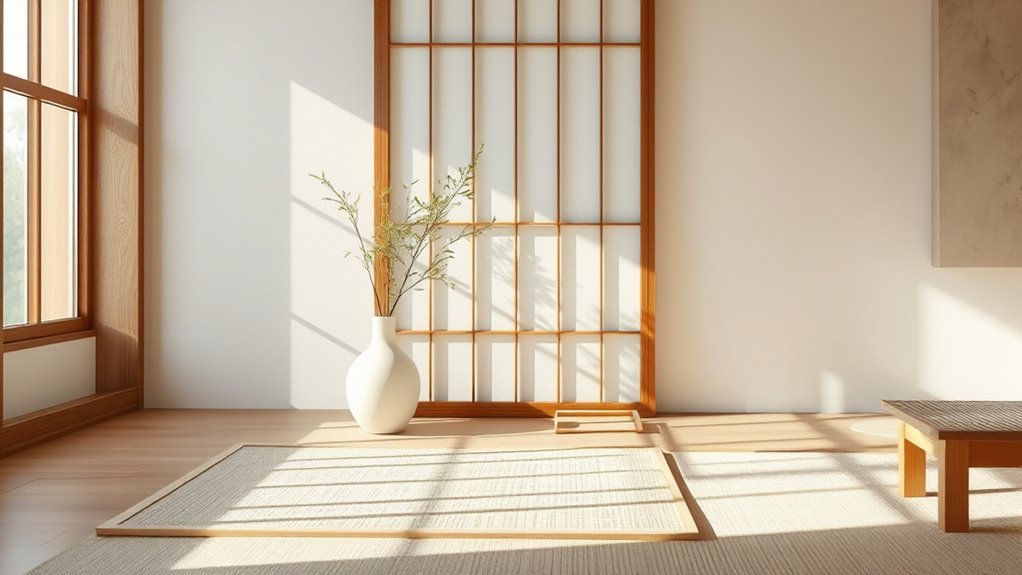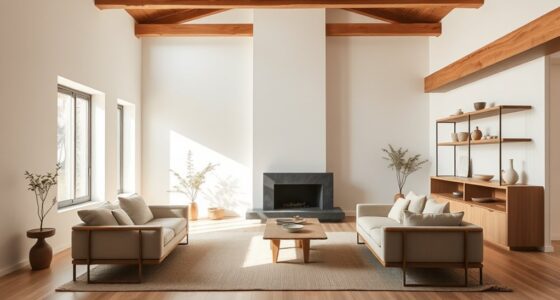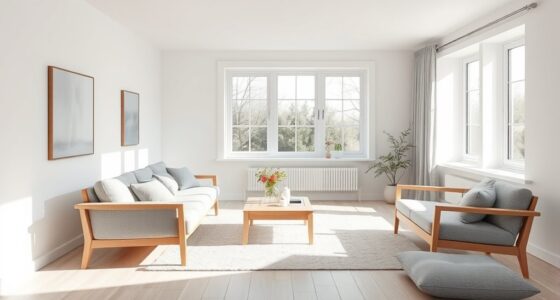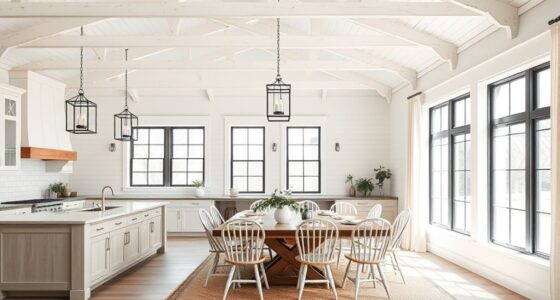Japandi combines Scandinavian calm with Japanese Zen, creating spaces that feel both cozy and peaceful. It emphasizes clean lines, natural materials like wood and linen, and neutral colors to foster tranquility. This style prioritizes functionality and simplicity, avoiding clutter and ornate details. By balancing minimalism with warmth, Japandi helps you design interiors that promote harmony and comfort. If you want to understand how this elegant blend of styles can transform your space, there’s more to discover.
Key Takeaways
- Japandi merges Japanese minimalism’s clean, functional design with Scandinavian cozy, inviting atmosphere for a balanced aesthetic.
- It emphasizes natural materials like wood, stone, and linen to create warmth and tactile comfort.
- The style features simple, sleek furniture with neutral tones to promote calm and serenity.
- Focus on quality, purpose-driven pieces enhances harmony and reduces clutter in living spaces.
- Overall, Japandi cultivates a tranquil, understated beauty blending Zen mindfulness with Scandinavian coziness.

Have you ever wondered how to blend the minimalist elegance of Japanese design with the cozy warmth of Scandinavian style? If so, you’re already on the right path to understanding Japandi. This design philosophy combines the best of both worlds—clean lines, simplicity, and functionality from Japan, paired with the inviting, relaxed atmosphere of Scandinavian interiors. At its core, Japandi emphasizes a minimalist aesthetic, which means focusing on quality over quantity and stripping away unnecessary clutter. It’s about creating a space that feels calm, balanced, and harmonious. To achieve this, you’ll want to prioritize natural materials. Think of wood, stone, linen, and rattan—these elements bring warmth and texture that soften the minimalism. Natural materials also help connect your space to nature, which is a essential aspect of both Japanese and Scandinavian design philosophies. Additionally, color harmony plays a crucial role in maintaining the serene atmosphere typical of Japandi interiors.
When you choose natural materials, you’re not just adding visual appeal; you’re creating a sensory experience. The tactile quality of a wooden table or a linen cushion invites comfort and tranquility. These materials are durable and sustainable, aligning with the eco-conscious principles of Japandi. Incorporating them thoughtfully into your decor can elevate the aesthetic from simply stylish to genuinely inviting. Simplicity is key, so opt for furniture with clean, sleek lines that highlight the beauty of the natural materials. Avoid ornate details or overly decorative elements—less is more. Instead, focus on functional pieces that serve a purpose and contribute to the overall harmony of the space.
Color palettes also play a essential role in achieving the Japandi look. Stick to neutral tones like soft beiges, warm greys, and muted browns. These hues enhance the minimalist aesthetic and create a soothing environment. You can add subtle pops of color through accessories like ceramics or textiles, but keep these accents minimal to maintain balance. Lighting is another fundamental aspect; choose natural light whenever possible, and supplement it with simple, unobtrusive fixtures that don’t distract from the clean lines of your design.
Ultimately, achieving a Japandi-inspired space involves thoughtful restraint and a focus on quality. By blending the minimalist aesthetic with natural materials, you create a setting that’s both serene and inviting. It’s about cultivating a lifestyle that values simplicity, craftsmanship, and comfort—where every piece has a purpose and every space promotes peace. So, embrace the effortless elegance of Japandi, and let your home become a sanctuary of calm and understated beauty.
Frequently Asked Questions
What Are the Key Color Palettes Used in Japandi Design?
When exploring Japandi design, you’ll notice it uses a calming color palette. You’ll primarily see neutral tones like soft whites, beiges, and grays that create a serene atmosphere. Earthy hues such as muted browns, olive greens, and warm taupes add warmth and depth. These colors work together to achieve a balanced, minimalist aesthetic that combines Scandinavian simplicity with Japanese Zen tranquility, making your space feel peaceful and inviting.
How Does Japandi Incorporate Sustainable and Eco-Friendly Materials?
You might think eco-friendly materials limit design options, but Japandi proves otherwise. It incorporates sustainable sourcing by choosing natural, renewable materials like bamboo, reclaimed wood, and organic textiles. These eco-friendly choices not only reduce environmental impact but also enhance the serene, minimalist aesthetic. By prioritizing sustainable sourcing, Japandi creates a harmonious space that’s both stylish and environmentally conscious, reflecting a commitment to eco-awareness without sacrificing beauty or functionality.
Can Japandi Style Be Adapted for Small Spaces?
You can absolutely adapt Japandi style for small spaces by focusing on small space solutions. Use multifunctional furniture like storage ottomans and fold-away desks to maximize your area without clutter. Keep the design minimal with clean lines, neutral tones, and natural materials. This approach maintains the calming, balanced aesthetic of Japandi while making your space functional and cozy. It’s all about thoughtful choices that blend style and practicality seamlessly.
What Are Common Furniture Choices in Japandi Interiors?
In Japandi interiors, you typically choose furniture that emphasizes simplicity and functionality. Think minimalist storage solutions like sleek cabinets and open shelving that keep clutter out of sight. You also incorporate textured fabrics, such as linen cushions or wool throws, to add warmth and tactile interest. Your goal is to create a space that’s calm and uncluttered, balancing clean lines with cozy elements, reflecting the perfect blend of Scandinavian and Japanese aesthetics.
How Does Lighting Influence Japandi Aesthetics?
You might think lighting isn’t essential, but it truly shapes a space’s mood. In Japandi interiors, natural light highlights the minimalist design and warm wood tones, creating a serene atmosphere. Ambient lighting complements this by softening shadows and emphasizing clean lines. Together, natural light and ambient lighting enhance the calming, balanced aesthetic, making your space feel cozy yet uncluttered, perfectly blending Scandinavian simplicity with Japanese Zen tranquility.
Conclusion
Now, imagine walking into a space that feels both serene and effortlessly stylish—where Scandinavian simplicity meets Japanese tranquility. As you breathe in, you sense a calm you can’t quite describe, yet it’s undeniable. Japandi isn’t just a trend; it’s a lifestyle waiting to transform your home into a haven. But what if the secret lies in blending these worlds perfectly? The journey to mastering Japandi has only just begun—are you ready to discover its true potential?









